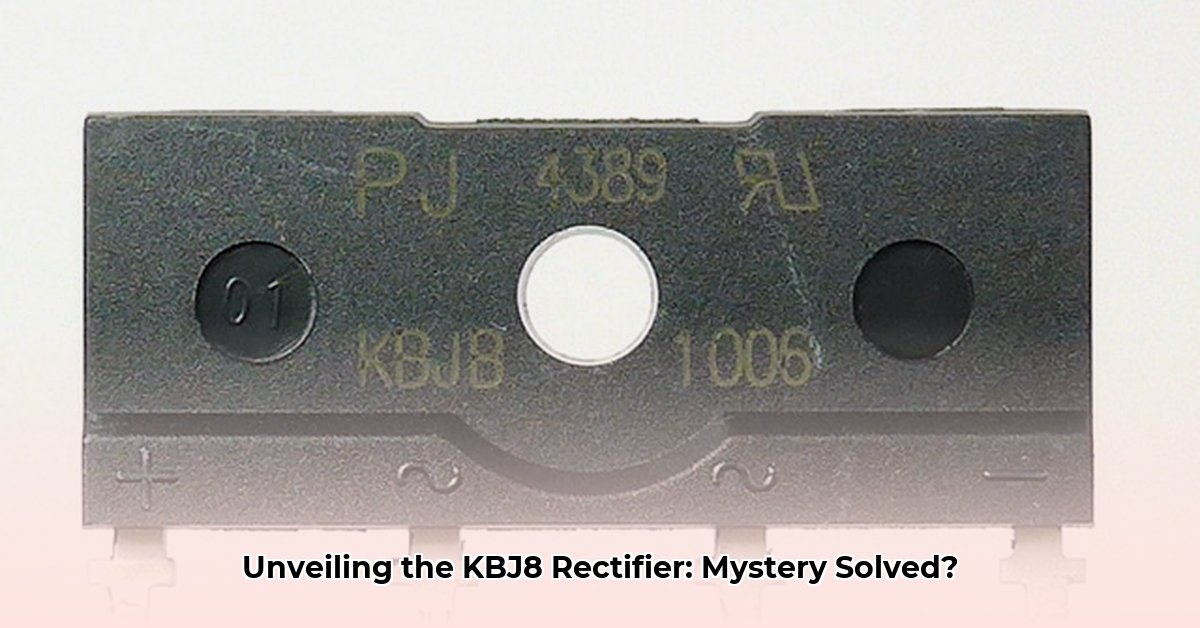
The KBJ8 bridge rectifier is a crucial component for converting alternating current (AC) to direct current (DC), a fundamental process in numerous electronic applications. However, understanding its capabilities and limitations requires a thorough analysis of its specifications and potential shortcomings. This article provides a detailed technical assessment, focusing on practical considerations for engineers and procurement professionals.
Key Specifications: Defining the KBJ8's Capabilities
The KBJ8's datasheet provides essential parameters, but critical information is often missing. This incomplete data significantly impacts its suitability for various applications. The table below summarizes the available specifications, highlighting areas requiring further clarification.
| Parameter | Value | Notes |
|---|---|---|
| Average Rectified Forward Current (Io) | 8 Amps | Maximum continuous current the rectifier can handle. |
| Peak Inverse Voltage (VRRM) | Unspecified | A critical missing specification. Requires clarification from the manufacturer. |
| Operating Junction Temperature Range | Specified Range | The datasheet likely provides this range, but its impact on performance needs further analysis. |
| Reverse Recovery Time (trr) | Likely Unspecified | Often absent from basic datasheets but crucial for switching applications. |
| Mean Time Between Failures (MTBF) | Likely Unspecified | This key reliability indicator is typically absent from less detailed datasheets. |
The absence of a specified Peak Inverse Voltage (VRRM) is a significant concern. This value represents the maximum reverse voltage the rectifier can withstand before breakdown. Without this crucial information, accurate circuit design and safety assessments are impossible. Similarly, the absence of Mean Time Between Failures (MTBF) data prevents a reliable assessment of the KBJ8's long-term performance. This is particularly important for applications demanding high reliability. How can we confidently predict its lifespan without crucial data points?
Performance Analysis: Strengths, Weaknesses, and Uncertainties
The stated 8-amp rating suggests the KBJ8 can handle substantial current loads. However, the lack of comprehensive data significantly limits our analysis. The incomplete temperature characterization hinders accurate performance prediction, potentially leading to design flaws and component failure. The missing MTBF data makes it unsuitable for critical systems where reliability is paramount. Does the KBJ8 truly meet the performance criteria if the actual operating conditions can´t be accurately predicted?
Application Considerations: A Cautious Approach
The data gaps make it difficult to definitively identify ideal applications for the KBJ8. Its 8-amp rating suggests suitability for power supplies and applications requiring moderate current handling. However, the lack of complete specifications makes it inappropriate for high-reliability or precision circuits. Consider the following: Given the lack of crucial data, is deploying the KBJ8 in safety-critical systems prudent?
Reliability and Testing: The Necessity of Rigorous Evaluation
The absence of reliability information necessitates thorough testing before incorporating the KBJ8 into any application. Without an MTBF or similar data, determining its long-term performance is uncertain. This makes it unsuitable for mission-critical systems without comprehensive testing. How can we justify using a system whose lifespan is undefined?
Before deploying the KBJ8, these tests are absolutely essential:
- Temperature Cycling Test: Subject the KBJ8 to repeated temperature cycles, monitoring forward voltage drop and reverse leakage current for variations or degradation.
- Load Testing: Apply a range of currents—including those at and slightly above the rated 8 amps—monitoring voltage drop and junction temperature.
- Accelerated Life Test: Simulate harsh operating conditions to estimate MTBF and predict lifespan.
- Reverse Voltage Stress Test: Apply reverse voltage pulses to assess its ability to withstand transient overvoltages.
These systematic tests help validate the component’s suitability and provide a clearer understanding of its limits and capacity.
Conclusion: Recommendations for Engineers and Procurement
The KBJ8's 8-amp rating offers potential, but significant data gaps render its application limited to non-critical systems. Until the manufacturer provides complete specifications, including VRRM and MTBF, its use should be restricted to applications where failure has minimal consequences. Thorough testing is a non-negotiable requirement before deployment in any critical application. A more comprehensive datasheet and reliability data are vital to determining the KBJ8's true suitability across a broader range of applications.